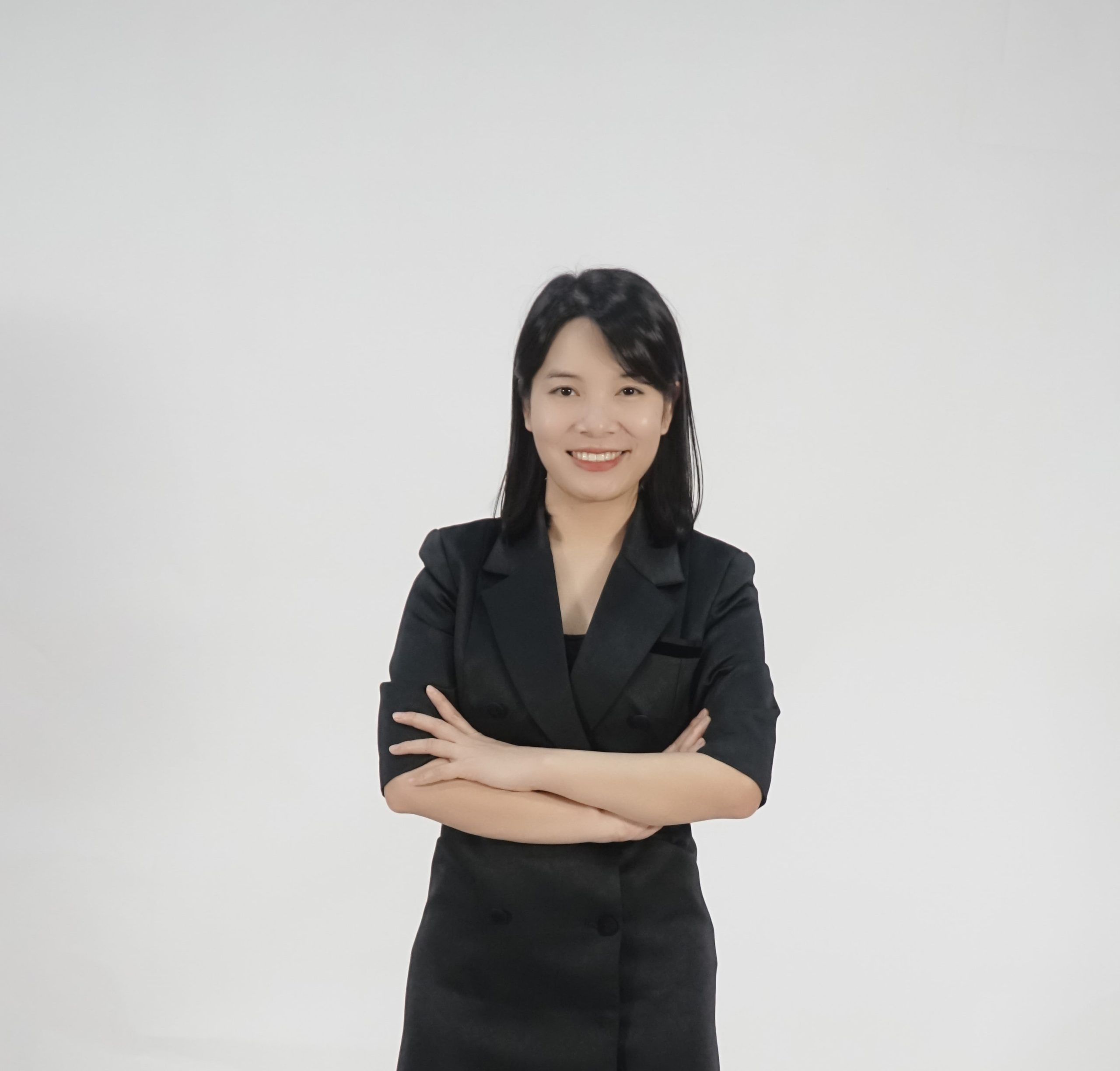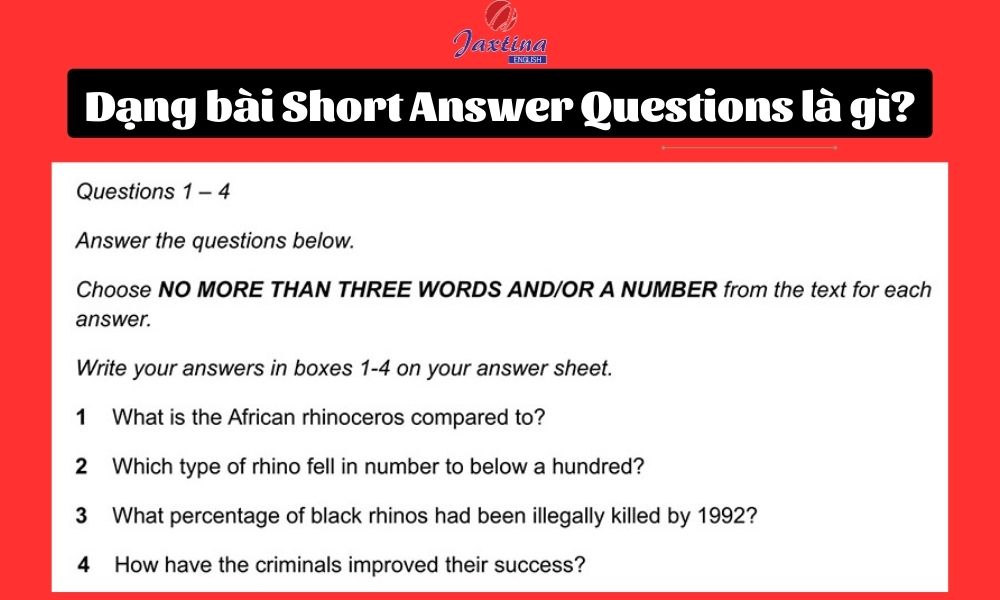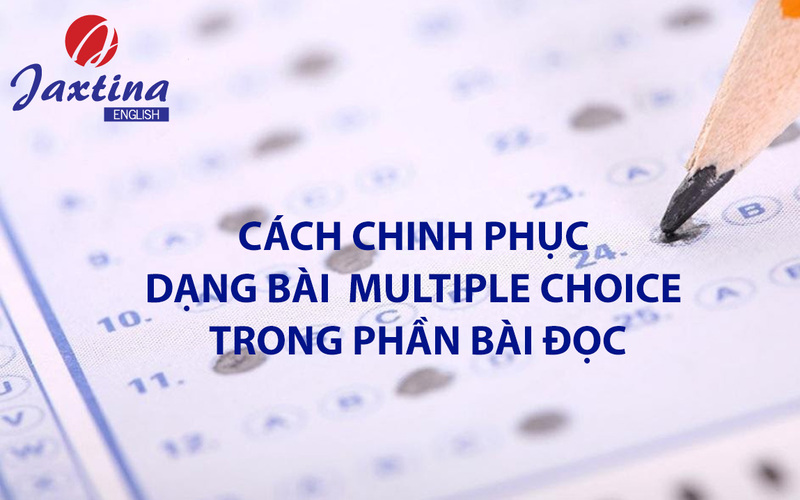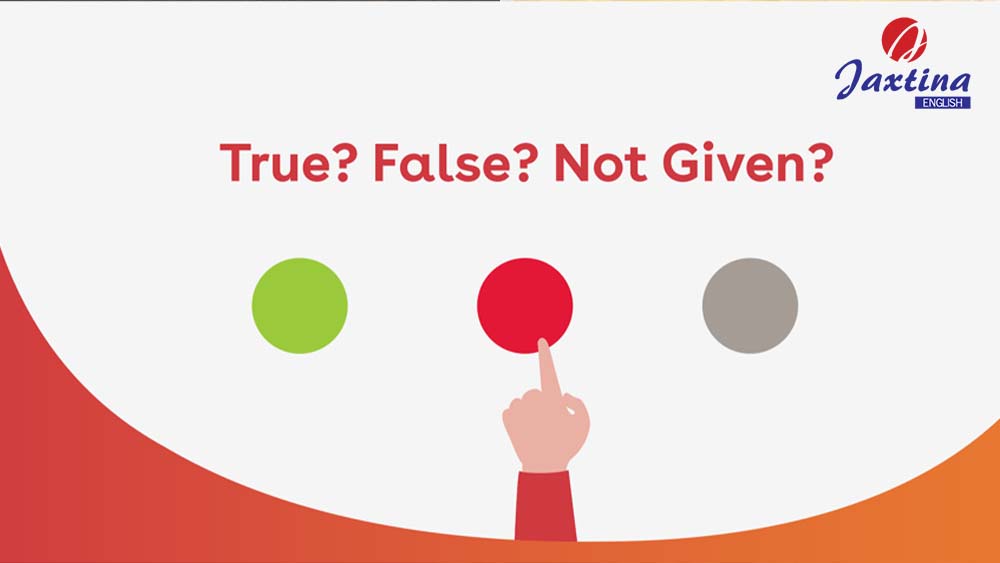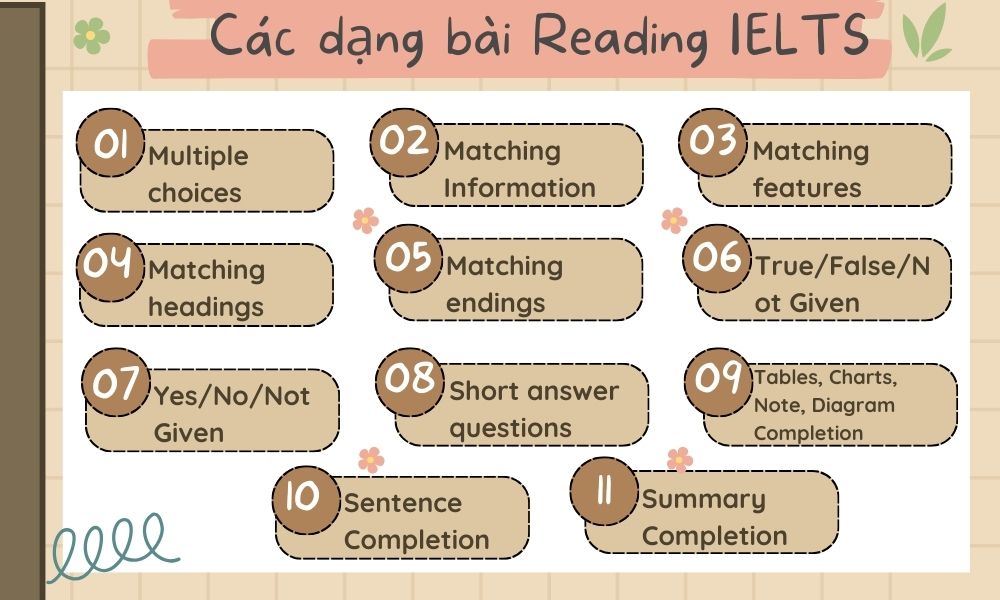4 bước làm dạng bài Short Answer Questions IELTS Reading
Kỹ năng Scanning và Skimming: Khái niệm và cách áp dụng
Nếu muốn chinh phục bài thi IELTS Reading, bạn sẽ cần thành thạo cách sử dụng kỹ năng Skimming và Scanning. Vậy Skimming và Scanning là gì? Cách áp dụng 2 kỹ năng này vào bài thi IELTS Reading như thế nào? Tất cả sẽ được trung tâm luyện thi IELTS Jaxtina English Center giải đáp cực chi tiết thông qua nội dung bài viết sau đây. Hãy xem ngay nhé!
Nội dung bài viết
1. Skimming và Scanning là gì?
Skimming là phương pháp đọc lướt để tìm nội dung chính của bài đọc và không đi sâu vào nội dung của một đoạn cụ thể nào. Bạn nên áp dụng kỹ năng Skimming khi gặp đoạn văn quá dài mà thời gian thi còn ít.
Còn Scanning là phương pháp đọc nhanh để tìm chi tiết cụ thể mà không cần hiểu nội dung của bài đọc. Bạn có thể áp dụng kỹ năng này để tìm kiếm các thông tin như tên riêng, ngày tháng, số liệu… trong đoạn văn, bài viết.
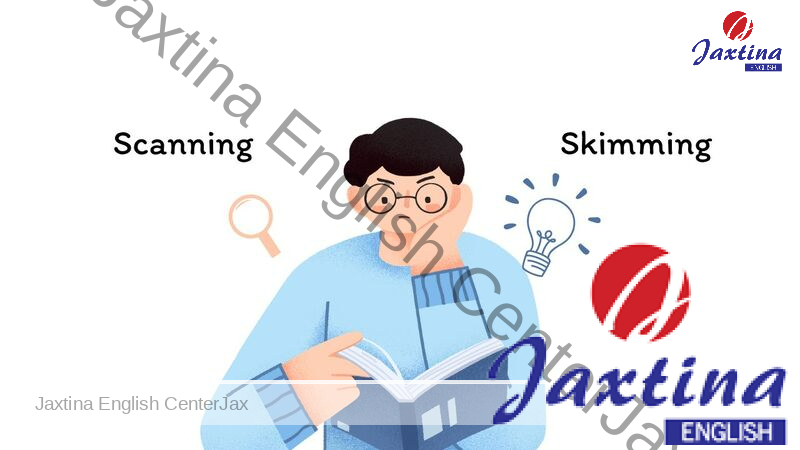
Scanning và Skimming là gì?
Có thể thấy rằng cả 2 kỹ năng Skimming và Scanning đều giúp người học IELTS tăng tốc độ tìm kiếm thông tin trong bài, từ đó tiết kiệm thời gian đọc cũng như tăng hiệu quả đọc hiểu. Đặc biệt, khi bài thi IELTS Reading mà thời gian bị hạn chế, việc kết hợp 2 kỹ năng này là vô cùng cần thiết để bạn có thể hoàn thiện bài làm đúng thời gian.
Xem Thêm: Cách luyện Reading IELTS hiệu quả
2. Áp dụng Skimming Scanning khi gặp dạng bài nào trong IELTS Reading?
Bạn nên áp dụng kỹ năng Skimming khi gặp phải các dạng bài như:
- Matching headings
- Summary completion
- Diagram Labelling
Còn đối với kỹ năng Scanning, bạn nên áp dụng khi làm các dạng bài sau đây trong IELTS Reading:
- Note/ Sentence completion
- True/ False/ Not given
- Yes/ No/ Not given
- Matching features
Lưu ý, riêng đối với dạng bài Multiple Choice trong IELTS Reading, bạn cần áp dụng cả hai kỹ năng để nắm được khái quát nội dung bài đọc và giúp việc khoanh vùng thông tin diễn ra nhanh chóng hơn.
Có Thể Bạn Quan Tâm: Cách làm dạng bài summary completion
3. Cách áp dụng kỹ năng Skimming và Scanning
Để áp dụng Skimming và Scanning, bạn hãy làm theo các bước sau đây:
Đối với kỹ năng Skimming:
- Bạn hãy bắt đầu bằng cách đọc tiêu đề chính và tiêu đề phụ của bài. Sau đó, bạn hãy đọc đoạn mở đầu để xác định nội dung chính trong bài bởi đây là phần dẫn dắt của tác giả vào chủ đề chính.
- Tiếp đến, bạn hãy đọc các câu chủ đề của từng đoạn, thường là câu đầu tiên của đoạn. Trong trường hợp đoạn văn được mở đầu bằng câu hỏi hoặc câu dẫn dắt, câu chủ đề sẽ nằm ở cuối đoạn.
- Sau đó, bạn hãy đọc lướt phần còn lại của các đoạn để lấy ý chính. Bạn cũng cần chú ý đến các câu hỏi WH – questions (Who, What, Which, …).
- Bạn cũnh cần lưu ý đến những từ quan trọng trong đoạn thường là các danh từ, số từ, các từ được in đậm hay viết hoa. Ngoài ra, bạn cũng hãy chú ý đến các marking words (từ dấu hiệu) như: because, but, then, …
Đối với kỹ năng Scanning:
- Phân tích cách tổ chức, bố cục của bài đọc.
- Xác định và ghi nhớ thông tin cần tìm kiếm, dựa vào từ khóa trong câu hỏi. Thông tin càng cụ thể thì khi trả lời câu hỏi càng đỡ mất thời gian.
- Phân loại từ khóa cần tìm thành từ khóa khó thay thế và từ khóa dễ thay thế:
- Từ khóa khó thay thế bao gồm tên riêng, số liệu, hầu như không bị thay thế trong bài đọc. Vì vậy, bạn cần ưu tiên loại từ khóa này để tìm kiếm thông tin.
- Từ khóa dễ thay thế bao gồm các danh từ và có thể bị thay thế bằng cách diễn đạt khác trong bài đọc. Do đó, bạn cần lưu ý khi sử dụng vì loại từ này chỉ dùng để tìm kiếm thông tin khi bài không chứa từ khóa khó thay thế.
- Đọc lướt bài đọc và tìm những từ khóa đó.
Có thể thấy, sự khác nhau khi thực hiện 2 kỹ năng Scanning và Skimming chính là cách đọc và thứ tự đọc. Cụ thể:
- Skimming yêu cầu người đọc đi theo trình tự từ trên xuống dưới bài đọc.
- Còn với Scanning, người đọc có thể chuyển ngay đến phần câu hỏi trước để xác định thông tin cần tìm kiếm, sau đó quay lại đọc bài, và thực hiện các bước đã nêu.
4. Bài tập áp dụng kỹ năng Scanning Skimming
Practice 1. Read the text and answer the questions using skimming and scanning. (Đọc bài văn và trả lời các câu hỏi sử dụng 2 kỹ năng skimming và scanning.)
ARE ELECTRIC CARS REALLY ECO-FRIENDLY?
Electric car drivers are saving the planet, right? Their vehicles produce none of the pollutants that dinosaurs-burning, fossil-fuel-powered machines do. That is the standard view, and governments around the world provide incentives to encourage the uptake of this new technology.
That is why a Tesla owner got a rude shock when he went to import his vehicle into Singapore – the first person to do so. The Tesla Model S is a 100% electric vehicle. It does not have an exhaust to emit from. So, what happened?
Instead of an expected rebate of around $10.000, he received a fine of the same amount for being a gross polluter. The company commented on the incident, “The Model S that our customer imported into Singapore left our factory only two years ago with energy consumption rated at 181 Wh/km. This qualifies as the cleanest possible category of car in Singapore and entitles the owner to an incentive rather than a fine.”
The Singapore authorities calculated the ‘carbon cost’ of generating the electricity that will be used to charge the car. This is the elephant in the trunk of electric vehicles. Where and how the power is produced is not often considered, but perhaps it should be. Let’s move the elephant up to the passenger seat and address it directly.
The authorities in Singapore apparently found the Tesla in question consumes 444 watt-hours of electricity per km (Wh/km) in tests. Without wanting to get too math-heavy, the number of 444 Wh/km does seem high. And as we still need power stations to produce such an amount of electric energy, the environmental impact is not so small as it seemed to be.
But what about the bigger picture – should we be factoring in the emissions of power stations when working out how green an electric car is? The logical answer is yes. Emissions shifted elsewhere are still emissions, and CO2 impacts the global atmosphere wherever it is released.
Question 1-4
1. What is the purpose of this text?
- To courage people to visit Singapore
- To show that electric cars are less eco-friendly than fossil-fuel-powered machines
- To show that we need to count the emissions of power stations to see how green an electric car is
2. When the owner of the electric car went to Singapore, he received
- a rebate of around $10.000
- a fine of around $12.000
- a fine of around $10.000
3. Why was the owner of the car considered a gross polluter provided that the car was a 100% electric vehicle that did not have an exhaust to emit from?
- Because the car was too expensive
- Because of the ‘carbon cost’ of generating the electricity that will be used to charge the car
- Because it has not been proven to be eco-friendly
4. Emissions shifted elsewhere are still emissions, and _______________ impacts the global atmosphere wherever it is released.
- Emissions from cars’ exhaust
- Pollutants
- CO2
Xem đáp án
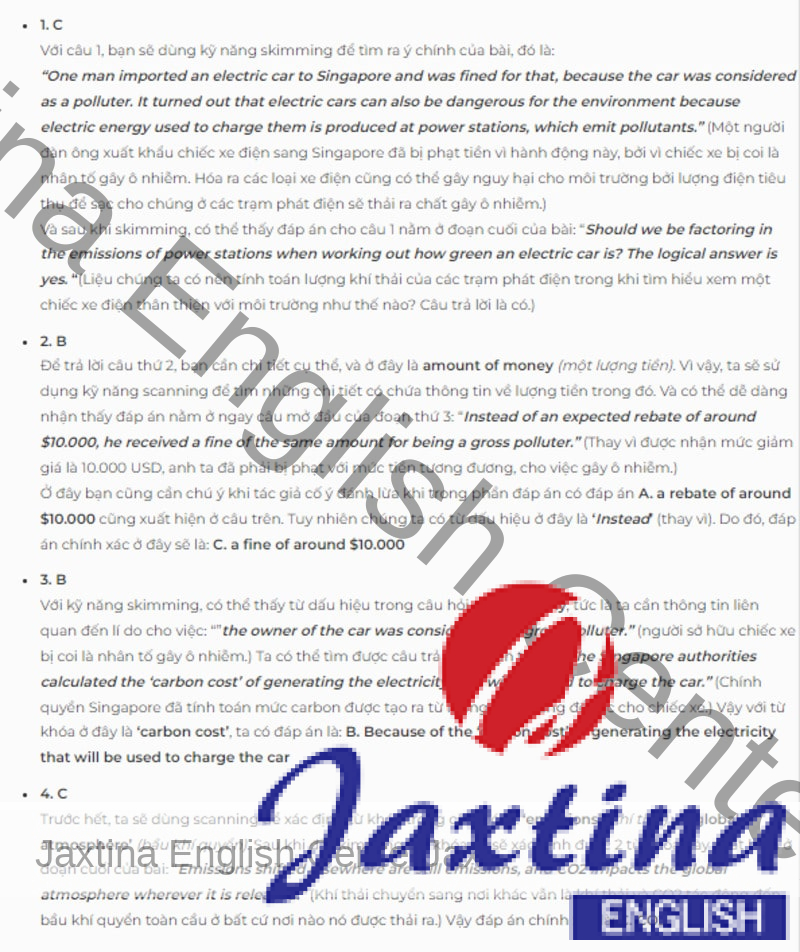
Practice 2. Read the text and answer the questions. (Đọc văn bản và trả lời câu hỏi.)
Unidentified Flying Object (or “UFO”) is a term commonly used to describe light shapes in the sky. It was first coined by the United States Air Force in 1952 to describe sightings of mysterious objects in the sky that could not be explained even after careful investigation. Nowadays, UFOs are spotted frequently and feature in numerous movies and TV shows. Another popular name for such an object is, “Flying Saucer,” in reference to the round shape of many UFOs.
The first widely publicized sighting was in 1947, by a pilot called Kenneth Arnold. Following this event, public sightings of UFOs increased dramatically. Movies and TV shows began featuring visitors from outer space, arriving on Earth in flying saucers. With the popularity of these images, many people claimed to have seen lights in the sky. Some experts believe that many people simply think they see UFOs because of the influence of TV and shows.
However, experts estimate that as little as 5% of these sightings could be called “unidentified.” Usually, these lights are made by aircraft, satellites, or weather balloons. Top secret air force activities during the Cold War may have been responsible for many of the UFO sightings in America and Europe. Although not actually aliens, the secretive nature of these flying objects is definitely unidentified.
Another popular idea concerning UFOs concerns the role of world governments. Specifically, people believe that the US government has discovered alien life and operates a “cover-up” to hide the truth from the public. The most widely believed cover-up is that of the Roswell Incident. In July 1947, a UFO supposedly landed in Roswell, New Mexico, and was examined and hidden by government agents. There have been many investigations into the Roswell incident, however, these reports always claim that no such event occurred.
Question 1-3
1. What is the aim of this report?
- To describe the history of alien life
- To describe the history of cover-ups
- To describe the history of UFO sightings.
2. Why are UFO sightings so controversial?
- They have never been proved.
- There are many sightings.
- The government cover-up sightings.
3. Which of the following is true?
- The first UFO was spotted in 1952.
- The word “UFO” was first used in 1952.
- The Roswell incident occurred in 1952.
Xem đáp án
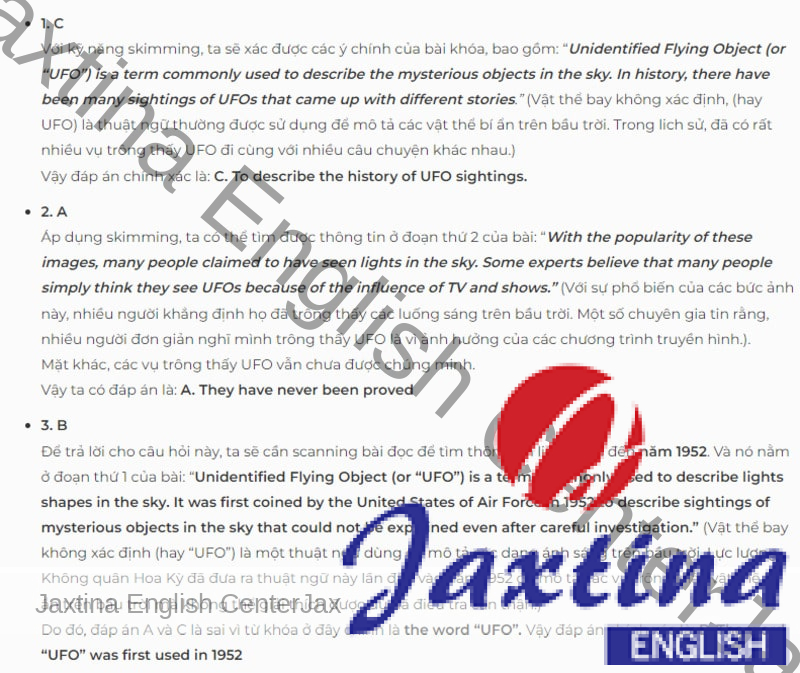
Jaxtina English Center hy vọng qua bài viết này, bạn sẽ có thêm kiến thức bổ ích về 2 kỹ năng Skimming và Scanning để vượt qua các bài đọc hóc búa và đạt được kết quả tốt nhất khi thi IELTS Reading. Hãy luyện đọc thường xuyên hơn để có cơ hội thực hành và áp dụng 2 kỹ năng trên một cách hiệu quả nhé!
Bài Viết Hữu Ích:

Đơn giản hoá việc học tiếng Anh

Tiên phong đào tạo
tiếng Anh toàn diện 4 kỹ năng.

